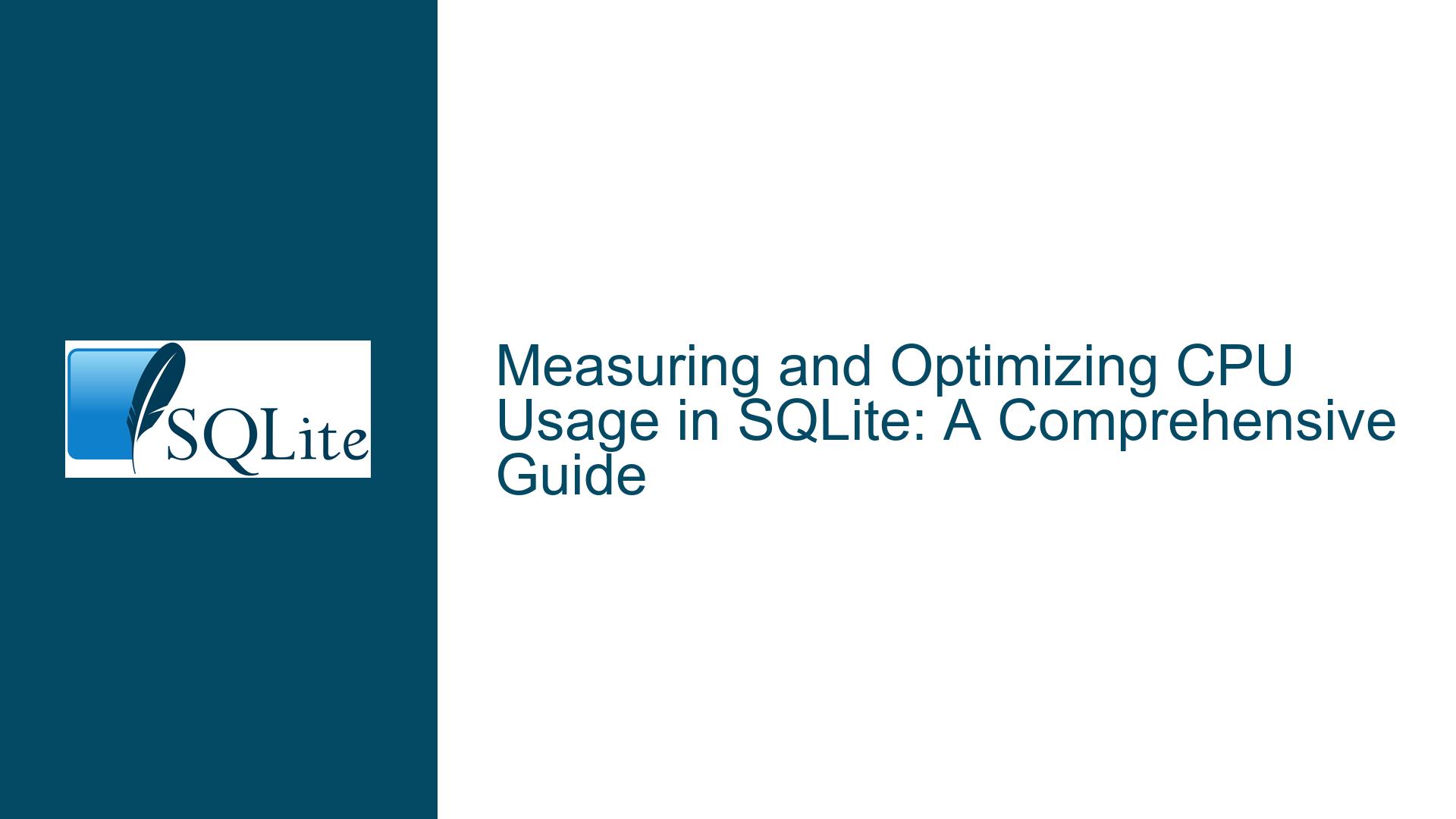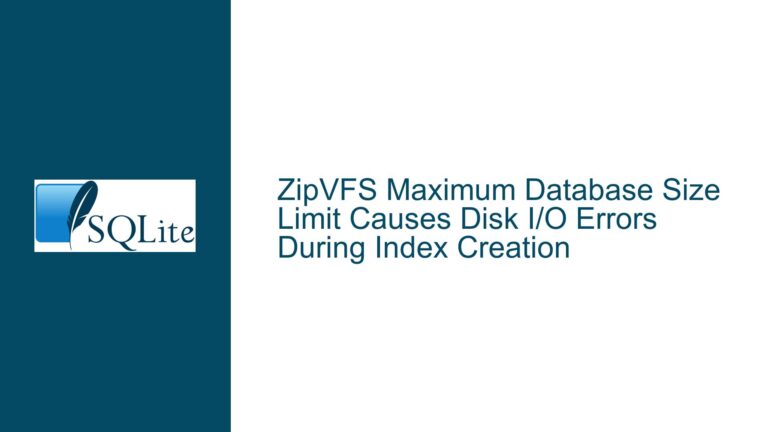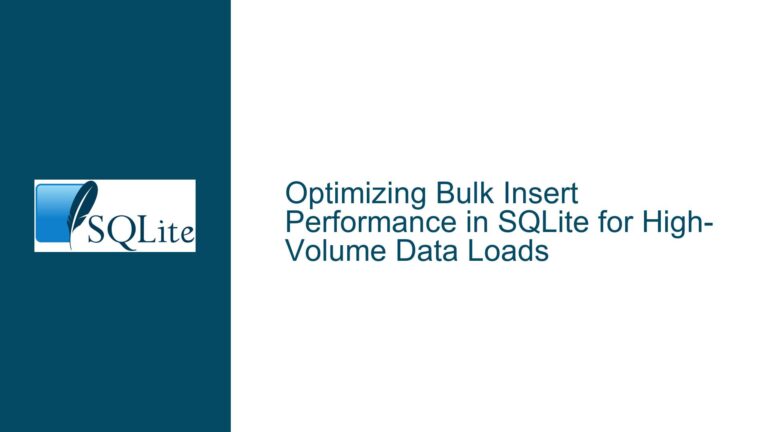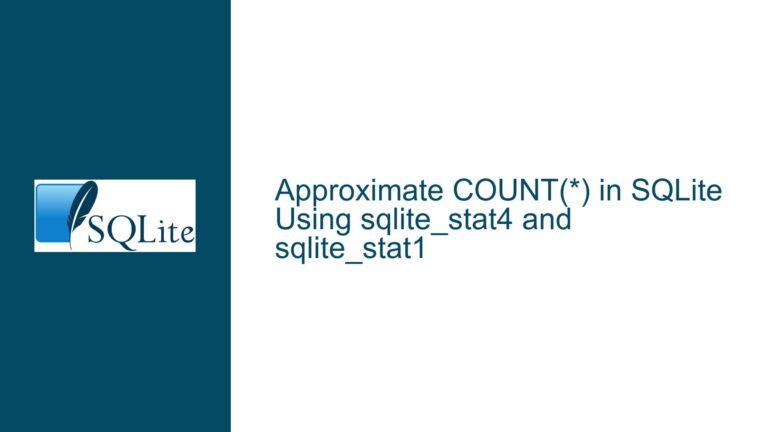Measuring and Optimizing CPU Usage in SQLite: A Comprehensive Guide
SQLite CPU Usage Measurement and Historical Context
SQLite, being one of the most widely deployed database engines, is renowned for its efficiency and low resource consumption. However, as applications grow in complexity and data volume increases, understanding and optimizing CPU usage becomes critical. The SQLite documentation provides a dedicated page titled "Measuring and Reducing CPU Usage in SQLite," which serves as a foundational resource for developers aiming to fine-tune their database performance. This page, however, has not been updated since SQLite version 3.26.0, leaving developers to wonder how newer features and optimizations impact CPU usage.
The historical context of SQLite’s performance improvements is essential to understanding the current state of CPU usage measurement. SQLite 3.26.0 introduced several enhancements, including the lookaside memory allocator, which significantly reduced the overhead associated with memory allocation and deallocation. Subsequent versions have introduced additional performance improvements, such as query planner enhancements, better indexing strategies, and more efficient use of CPU cycles. These changes, while beneficial, have not been documented in the context of CPU usage measurement, leading to a gap in the available resources for developers.
The lookaside memory allocator, for instance, is a critical feature that reduces the frequency of expensive memory allocation operations. By maintaining a pool of pre-allocated memory blocks, SQLite can quickly allocate and deallocate memory for small objects, thereby reducing CPU overhead. This feature, combined with other optimizations, has made SQLite more efficient in handling high-frequency transactions and complex queries. However, the absence of updated documentation means that developers may not be fully aware of how these features impact CPU usage or how to measure their effectiveness.
Moreover, the evolution of SQLite’s query planner has introduced new strategies for optimizing query execution. The query planner is responsible for determining the most efficient way to execute a given SQL statement, and its decisions directly impact CPU usage. Recent versions of SQLite have improved the query planner’s ability to handle complex joins, subqueries, and indexing, leading to more efficient use of CPU resources. However, without updated guidance on measuring CPU usage, developers may struggle to quantify the benefits of these improvements.
In summary, the lack of updates to the "Measuring and Reducing CPU Usage in SQLite" page has created a knowledge gap for developers. While SQLite has introduced numerous performance enhancements since version 3.26.0, the documentation has not kept pace, leaving developers to rely on outdated information. This guide aims to bridge that gap by providing a detailed analysis of SQLite’s CPU usage measurement techniques, the impact of recent optimizations, and practical steps for optimizing CPU usage in modern SQLite deployments.
Impact of Lookaside Memory Allocator and Query Planner Optimizations
The lookaside memory allocator and query planner optimizations are two of the most significant enhancements introduced in SQLite since version 3.26.0. These features have a direct impact on CPU usage, and understanding their role is crucial for optimizing database performance.
The lookaside memory allocator is designed to reduce the overhead associated with memory allocation and deallocation. In traditional memory allocation schemes, each allocation request involves a system call to the operating system, which can be costly in terms of CPU cycles. The lookaside memory allocator mitigates this overhead by maintaining a pool of pre-allocated memory blocks. When a small object needs to be allocated, SQLite can quickly assign a block from the pool, avoiding the need for a system call. Similarly, when an object is deallocated, the memory block is returned to the pool for reuse. This mechanism significantly reduces the CPU overhead associated with memory management, particularly in applications with high-frequency transactions.
The impact of the lookaside memory allocator on CPU usage can be measured by comparing the performance of SQLite with and without this feature enabled. In general, enabling the lookaside memory allocator results in a noticeable reduction in CPU usage, especially in workloads that involve frequent small memory allocations. However, the exact impact depends on the specific workload and the size of the lookaside memory pool. Developers can experiment with different pool sizes to find the optimal configuration for their application.
Query planner optimizations, on the other hand, focus on improving the efficiency of SQL statement execution. The query planner is responsible for determining the most efficient way to execute a given SQL statement, and its decisions directly impact CPU usage. Recent versions of SQLite have introduced several enhancements to the query planner, including better handling of complex joins, subqueries, and indexing.
One of the key improvements in the query planner is its ability to leverage indexes more effectively. Indexes are critical for speeding up query execution, but they can also introduce additional CPU overhead if not used correctly. The query planner in modern versions of SQLite is better at identifying when to use an index and when to perform a full table scan. This optimization reduces unnecessary CPU cycles and improves overall query performance.
Another important enhancement is the query planner’s ability to handle complex joins more efficiently. Joins are one of the most CPU-intensive operations in SQLite, and optimizing their execution can have a significant impact on CPU usage. The query planner now considers a wider range of join strategies and selects the one that minimizes CPU usage while still delivering accurate results. This improvement is particularly beneficial for applications that involve large datasets and complex queries.
In addition to these optimizations, SQLite has introduced several other performance improvements that indirectly impact CPU usage. For example, the introduction of the WAL (Write-Ahead Logging) mode has reduced the contention between read and write operations, leading to more efficient use of CPU resources. Similarly, the introduction of the incremental vacuum feature has reduced the overhead associated with database maintenance operations, freeing up CPU cycles for other tasks.
In summary, the lookaside memory allocator and query planner optimizations are two of the most significant enhancements introduced in SQLite since version 3.26.0. These features have a direct impact on CPU usage, and understanding their role is crucial for optimizing database performance. By leveraging these optimizations, developers can reduce CPU overhead and improve the efficiency of their SQLite deployments.
Practical Steps for Measuring and Optimizing CPU Usage in SQLite
Measuring and optimizing CPU usage in SQLite requires a combination of tools, techniques, and best practices. This section provides a detailed guide on how to measure CPU usage, identify bottlenecks, and implement optimizations to reduce CPU overhead.
The first step in measuring CPU usage is to use the appropriate tools. SQLite provides several built-in mechanisms for monitoring performance, including the sqlite3_status function and the PRAGMA statements. The sqlite3_status function allows developers to query various performance metrics, including the number of memory allocations, the amount of memory used, and the number of page cache hits and misses. These metrics can provide valuable insights into how SQLite is using CPU resources.
In addition to the built-in tools, developers can use external profiling tools to measure CPU usage. Profiling tools such as gprof, perf, and Valgrind can provide detailed information about the CPU usage of individual SQLite functions and queries. These tools can help identify hotspots in the code where CPU usage is particularly high, allowing developers to focus their optimization efforts on the most critical areas.
Once CPU usage has been measured, the next step is to identify and address bottlenecks. One common source of CPU overhead is inefficient queries. Queries that involve full table scans, complex joins, or subqueries can consume a significant amount of CPU resources. Developers should use the EXPLAIN and EXPLAIN QUERY PLAN statements to analyze the execution plan of their queries and identify potential inefficiencies. The EXPLAIN statement provides a detailed breakdown of how SQLite executes a query, including the order of operations and the use of indexes. The EXPLAIN QUERY PLAN statement provides a high-level overview of the query plan, making it easier to identify areas for improvement.
Another common source of CPU overhead is inefficient use of indexes. Indexes are critical for speeding up query execution, but they can also introduce additional CPU overhead if not used correctly. Developers should ensure that their queries are using indexes effectively and that the indexes themselves are optimized for the specific workload. This may involve creating additional indexes, modifying existing indexes, or using covering indexes to reduce the need for additional table lookups.
In addition to query optimization, developers should consider the impact of database configuration on CPU usage. SQLite provides several configuration options that can influence CPU usage, including the PRAGMA journal_mode, PRAGMA synchronous, and PRAGMA cache_size statements. The PRAGMA journal_mode statement controls the journaling mode used by SQLite, which can impact both performance and durability. The WAL mode, for example, reduces contention between read and write operations, leading to more efficient use of CPU resources. The PRAGMA synchronous statement controls the level of synchronization between SQLite and the underlying file system, with higher levels of synchronization providing greater durability at the cost of increased CPU usage. The PRAGMA cache_size statement controls the size of the page cache, which can impact both performance and memory usage.
Finally, developers should consider the impact of application design on CPU usage. Inefficient application logic, such as excessive use of transactions or frequent database connections, can introduce additional CPU overhead. Developers should strive to minimize the number of database connections and transactions, and use connection pooling where appropriate. Additionally, developers should consider the impact of concurrency on CPU usage. High levels of concurrency can lead to contention for CPU resources, particularly in multi-threaded applications. Developers should use appropriate locking mechanisms and consider using the WAL mode to reduce contention and improve performance.
In summary, measuring and optimizing CPU usage in SQLite requires a combination of tools, techniques, and best practices. By using the appropriate tools to measure CPU usage, identifying and addressing bottlenecks, and optimizing database configuration and application design, developers can reduce CPU overhead and improve the efficiency of their SQLite deployments.






